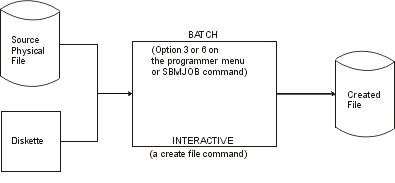Create the file by running a CL command that corresponds to the type of DDS file you are creating.
The file types and their corresponding commands are listed in the following table.
| File type | Command |
|---|---|
| Physical file | CRTPF |
| Logical file | CRTLF |
| Display file | CRTDSPF |
| Printer file | CRTPRTF |
| ICF file | CRTICFF |
When you issue a CL command to create a file, the DDS is retrieved from the source file and validated, and a file is created as shown in the following figure. The file is created only if there are no errors in the DDS of equal or greater severity than the severity specified on the GENLVL parameter of the CL command that creates the file. Thus, you can use the GENLVL parameter to control the allowable error severity when creating the file. Depending on the options you specify on the OPTION and FLAG parameters, a DDS source (or compiler) listing can also be created. The DDS listing contains the data description and error information.
You can use the FLAG parameter to specify the minimum severity of DDS messages which will be printed. For example, you can suppress the warning messages for field overlapping.
